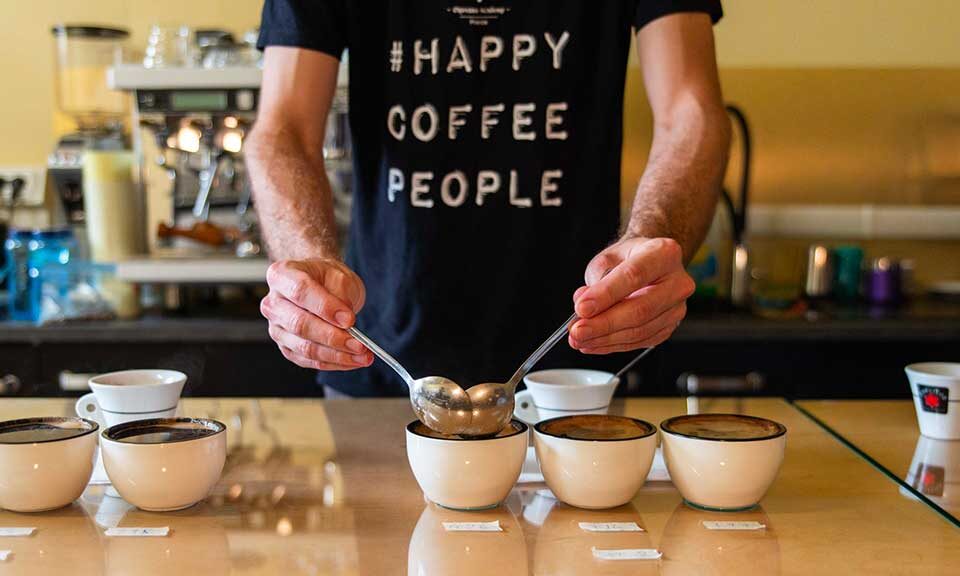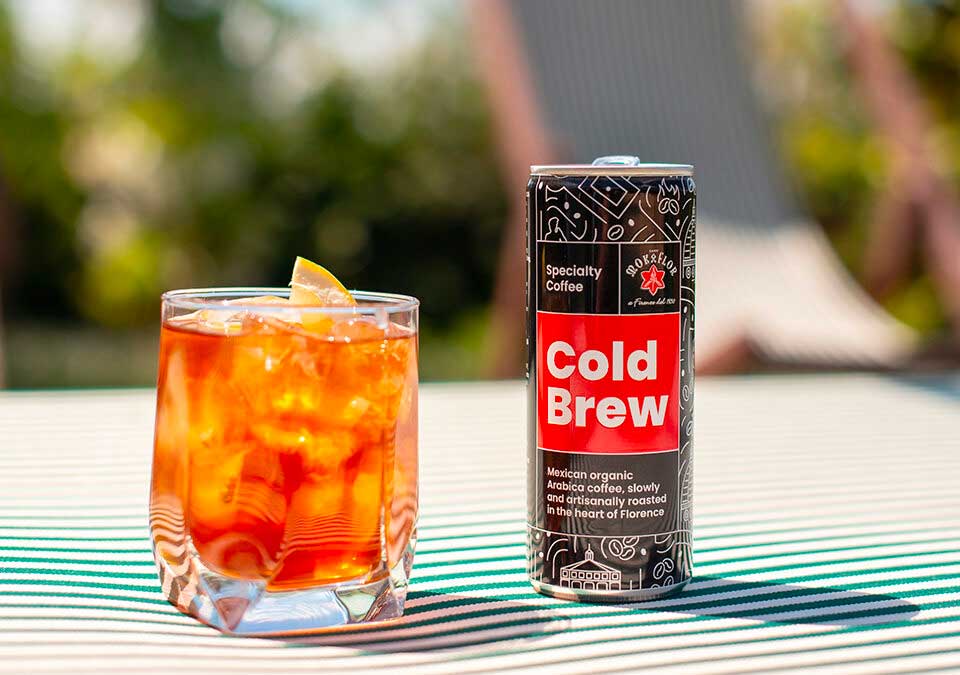
The importance of the triangular test in coffee tasting
10 July 2024
How to brew coffee at home with a French Press: the complete guide for a perfect filter coffee
4 November 2024How to Open a Bike Coffee Cart: A Comprehensive Guide

In recent years, the bike coffee cart has emerged as a unique and appealing business model, capturing the hearts of coffee enthusiasts and entrepreneurs alike.
These mobile coffee units combine the love of cycling with the art of coffee making, offering a flexible and eco-friendly alternative to traditional brick-and-mortar cafés. The benefits of running a bike coffee cart are manifold: low start-up costs, mobility that allows for reaching diverse customer bases, and a sustainable approach that aligns with the growing trend toward green business practices.
However, the success of such a venture hinges on meticulous planning and strategic execution. In this comprehensive guide, we’ll explore everything you need to know about starting your own bike coffee cart business, from understanding the concept to mastering daily operations and marketing strategies.
What is a Bike Coffee Cart?
A bike coffee cart is a mobile coffee shop mounted on a bicycle, designed to serve high-quality coffee on the go. These innovative units typically feature all the essential coffee-making equipment, including espresso machines, grinders, and storage for beans and other ingredients, all compactly fitted onto a bicycle.
The concept has evolved, inspired by the broader trend of mobile food and beverage vendors. The history of mobile coffee carts dates back to the early 20th century, with simple pushcarts serving coffee in busy urban areas. Over the decades, these have transformed into more sophisticated and specialized units, incorporating modern technology and sustainable practices. Today, bike coffee carts symbolize entrepreneurial ingenuity and respond to the increasing demand for convenient, high-quality coffee experiences in various locations.
Advantages of a Bike Coffee Cart
One of the most significant advantages of a bike coffee cart is its low start-up costs. Unlike traditional coffee shops, which require substantial investment in real estate, interior design, and extensive equipment, a bike coffee cart demands a relatively modest initial outlay. This makes it an attractive option for aspiring entrepreneurs keen to enter the coffee business without breaking the bank.
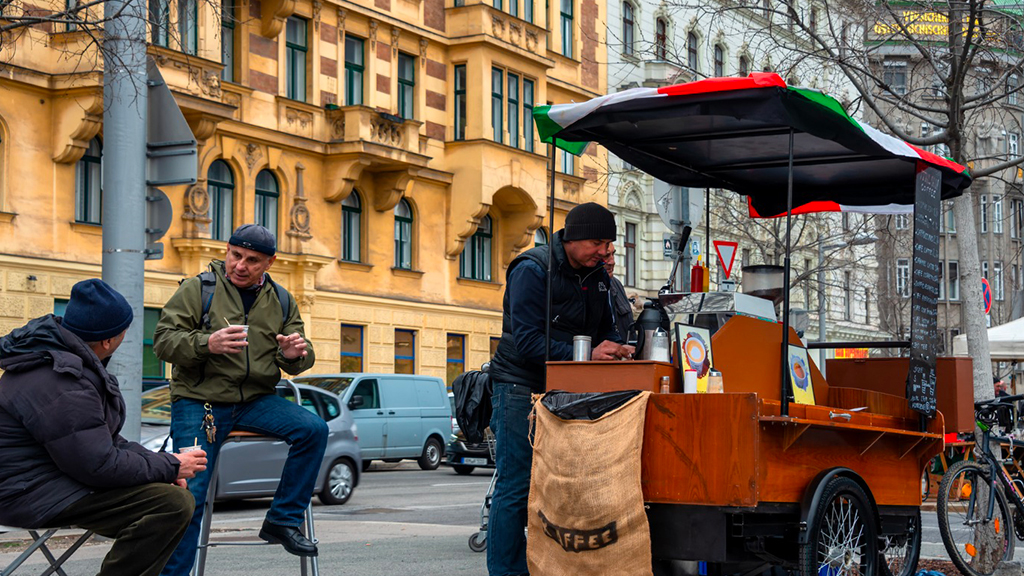
Mobility and flexibility are other key benefits. A bike coffee cart allows you to take your business to your customers, whether they’re at busy city centers, parks, events, or festivals. This mobility enables you to adapt to different market conditions and reach a diverse customer base, maximizing your sales opportunities.
Eco-friendliness and sustainability are integral to the appeal of bike coffee carts. These units typically have a smaller carbon footprint compared to traditional cafés, as they require less energy and resources to operate. Additionally, many bike coffee carts emphasize the use of biodegradable or recyclable materials, further contributing to environmental sustainability. This aligns with the growing consumer preference for businesses that prioritize green practices, enhancing your brand’s appeal and reputation.
Planning Your Bike Coffee Cart Business
Before you launch your bike coffee cart, it’s essential to analyze the local demand for coffee. Start by exploring various locations where people might be interested in buying coffee on-the-go, such as busy city centers, parks, universities, and office districts. Conduct surveys or informal interviews to gauge the coffee preferences and buying habits of potential customers in these areas. Use online tools and local business reports to assess the overall coffee consumption trends in your target locations.
Identifying your target customers is a critical step in your market research. Consider the demographics and psychographics of the people who are most likely to buy coffee from your bike cart. Are they office workers looking for a morning caffeine fix, students needing a study break, or park-goers enjoying a leisurely day out? Understanding the lifestyle, preferences, and needs of your target customers will help you tailor your offerings and marketing strategies effectively.
Studying your competitors is essential to identify gaps in the market and opportunities for differentiation. Visit other coffee shops, bike coffee carts, and mobile food vendors in your area to observe their operations, menu offerings, pricing, and customer service. Take note of what they do well and where they might be lacking. This information will help you develop a unique value proposition that sets your bike coffee cart apart from the competition. Consider what additional features or services you can offer, such as specialty drinks, eco-friendly packaging, or loyalty programs, to attract and retain customers.
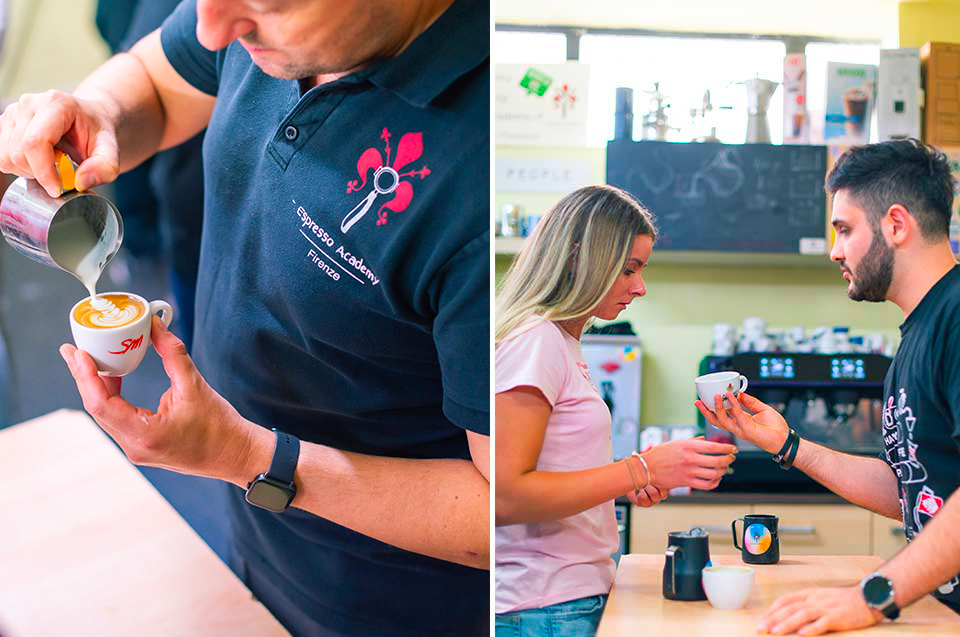
Importance of Training. A crucial aspect of a Bike Coffee Cart’s success is solid training in coffee preparation and coffee-based drinks. An in-depth knowledge of extraction techniques, coffee varieties, and equipment is essential to offer high-quality products to customers.
For this reason, attending specialized courses like those offered by Espresso Academy is highly recommended. The Advanced Barista and Coffee Brewing courses at Espresso Academy are ideal for acquiring the practical and theoretical skills needed to become an expert in coffee preparation.
Additionally, Espresso Academy offers a wide range of coffee-related courses, specific courses on opening and managing businesses in the sector (even Online!), and personalized consulting services from our team of experts. Investing in training will not only improve the quality of the service provided but will also help to stand out from the competition and build a strong reputation in the market.
Choosing a Business Model
Choosing the right business model is a critical decision that will shape the direction and operations of your bike coffee cart business. Here, we’ll explore the pros and cons of different approaches to help you make an informed choice.
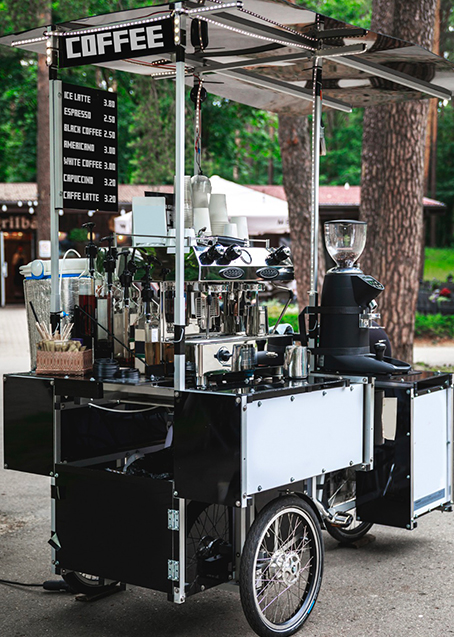
For those considering the independent model, the main advantages include creative control, flexibility, and lower initial costs. Running an independent bike coffee cart allows you complete creative freedom over your brand, menu, and operations, enabling you to tailor your offerings to suit your vision and the preferences of your local market. As an independent owner, you can quickly adapt to market changes, customer feedback, and new trends without needing approval from a corporate entity. Generally, starting an independent business involves lower upfront costs compared to buying into a franchise, which often requires a significant investment for the brand name and support services.
However, the independent model also has its challenges. Without the backing of an established brand with proven business systems, you’ll need to handle all aspects of the business, from marketing to supply chain management, on your own. Building brand recognition from scratch can be challenging and time-consuming. Without the reputation of a known franchise, it may take longer to establish a loyal customer base.
On the other hand, the franchise model offers distinct benefits. Joining a franchise like Coffee-Bike allows you to leverage the established brand name, which can attract customers and generate immediate interest in your bike coffee cart. Franchises typically provide extensive training and ongoing support in areas such as marketing, operations, and supply chain management, which can be invaluable for first-time entrepreneurs. Moreover, franchises offer a tested and refined business model with established systems and processes, reducing the risks associated with starting a new business.
Despite these advantages, the franchise model also comes with certain drawbacks. Buying into a franchise often requires a substantial initial investment, including franchise fees, equipment costs, and potentially ongoing royalty payments. Operating under a franchise means adhering to the franchisor’s guidelines and restrictions, which can limit your ability to make independent decisions about your business.
Obtaining Necessary Permits and Licenses

Launching a bike coffee cart business involves navigating various legal and regulatory requirements to ensure smooth and lawful operations. These considerations may vary significantly from one country to another, but here are the general steps and considerations applicable globally:
To legally operate your bike coffee cart, you must obtain the appropriate permits and licenses. These typically include:
- Business License: Almost all municipalities require a business license to operate legally. The process and fees for obtaining a business license vary by country and locality. It’s crucial to check with your local government office or online government portals to understand the specific requirements.
- Vendor Permit: Since you’ll be selling food and beverages, you’ll likely need a vendor permit. This might involve specific requirements depending on your location. For instance, street vending regulations in New York City differ from those in Tokyo.
Health Department Permit: Food and beverage businesses must comply with health and safety regulations. You will need to pass an inspection by the health department and obtain a permit. This includes ensuring your cart meets sanitary standards and your staff is trained in food safety. In some countries, such as Australia, a Food Safety Supervisor certificate is mandatory.
Health and Safety Regulations
Compliance with health and safety regulations is critical for any food service business. Key aspects include:
- Sanitation Standards: Your bike coffee cart must adhere to strict sanitation standards, which are often dictated by national or local health authorities. This includes regular cleaning of equipment and surfaces, proper waste disposal, and ensuring a hygienic food preparation area.
- Food Handler Certification: Some regions require that all food handlers complete a certification course to ensure they understand food safety practices. For example, the Food Safety and Hygiene (Level 2) certification in the UK or the ServSafe Food Handler certification in the US.
- Health Inspections: Regular health inspections by local health authorities are mandatory. These inspections will check for compliance with food safety regulations and ensure your cart is up to standard.
Local Zoning Laws and Parking Restrictions
Understanding and adhering to local zoning laws and parking restrictions is essential to avoid fines and operational disruptions:
- Zoning Laws: Zoning laws dictate where you can operate your bike coffee cart. Certain areas may be off-limits for commercial activities, while others may have specific hours during which you can operate. For example, in the US, zoning regulations can vary significantly between states and even cities. In European cities like Paris, specific zones may be designated for street vendors.
- Parking Permits: If you plan to operate in a fixed location, such as a park or outside a business, you may need a parking permit. Some cities have designated spots for food carts, while others require you to move periodically. In places like Singapore, there are specific areas allocated for mobile food vendors.
- Special Event Permits: If you plan to serve at festivals, markets, or other events, you may need a special event permit. These permits often come with additional requirements and fees. For instance, in Canada, participating in events like farmers’ markets or festivals typically requires a temporary food vendor permit.

Designing and Equipping Your Bike Coffee Cart
Choosing the right bike and cart is crucial for the success of your bike coffee cart business. Your selection will impact not only the functionality and efficiency of your operations but also the overall customer experience. Here are the key considerations:
Types of Bikes Suitable for Coffee Carts
Selecting the right bike and cart is crucial for the success of your bike coffee cart business. The type of bike you choose should be robust and capable of carrying all your necessary equipment and supplies. Cargo bikes are an excellent option due to their large carrying capacity and sturdy build, making them ideal for heavy loads. Tricycles are also popular because their three-wheel design offers additional stability, which is beneficial when preparing and serving coffee. For those needing to cover longer distances or navigate challenging terrains, electric bikes provide the necessary extra power, easing the strain on the rider.
When deciding between a custom-built cart and a pre-fabricated one, each option has its advantages and disadvantages.
- Custom-built carts allow for tailored designs that meet your specific needs and preferences. They offer unique branding opportunities, making it easier for your business to stand out. However, custom-built carts often come with higher costs and longer build times.
- On the other hand, pre-fabricated carts are typically more cost-effective and readily available, allowing you to start your business more quickly. These carts come with tested designs that have been optimized for efficiency and functionality, though they offer less flexibility for customization and may look more generic.
Regardless of the choice between custom-built and pre-fabricated, your cart must feature durable construction to withstand daily use and various weather conditions. An efficient layout will help streamline operations, enabling you to serve customers quickly and efficiently. Adequate storage is crucial for keeping coffee beans, milk, cups, and other essentials. Consideration of power supply options, such as battery packs, solar panels, or connections to external power sources, is also important.
Additionally, the cart should meet hygiene and sanitation standards, with easy-to-clean surfaces and features like sinks and waste disposal systems to comply with local health regulations.
Essential Equipment and Supplies
Equipping your bike coffee cart with the right tools and supplies is essential for smooth and efficient operations. Here are the key components you’ll need:
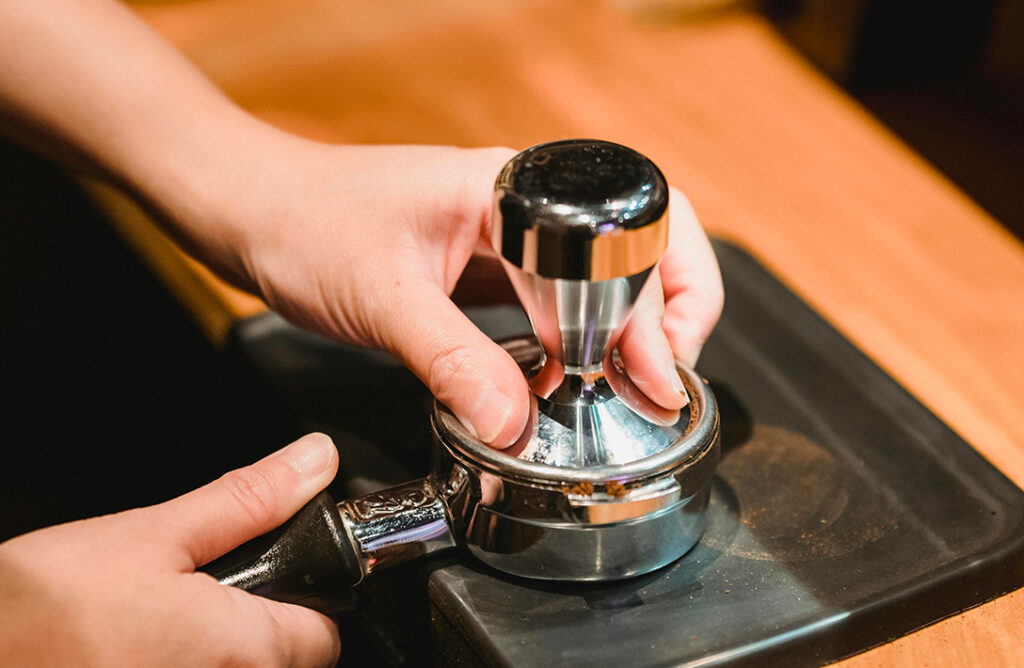
Coffee Machines and Grinders
A high-quality espresso machine is the heart of any coffee business. For a bike coffee cart, consider compact, portable models that do not compromise on performance, even a Lever Machine could be a great option. Additionally, one or even two good coffee grinders are crucial for achieving the perfect grind size, which is essential for brewing excellent coffee.
Water Supply and Waste Management
Efficient water management is vital for any mobile coffee business. You’ll need a reliable water supply system, which typically includes a freshwater tank and a wastewater tank. Ensure your cart has a pump system to supply water to your coffee machine and a method to heat water if your espresso machine requires it. Managing wastewater is equally important to comply with health regulations and maintain hygiene standards. Look for self-contained systems that are easy to clean and maintain.
Storage for Beans, Milk, and Other Ingredients
Proper storage solutions are essential to keep your ingredients fresh and organized. Airtight containers for coffee beans are necessary to preserve their freshness and flavor. For milk and other perishable items, consider using a compact refrigerator or a cooler with ice packs, especially if you operate in warm climates. Additionally, you’ll need storage compartments for syrups, cups, lids, napkins, and other supplies. Ensuring everything is within easy reach will streamline your operations and enhance customer service.
Branding and Aesthetics
Creating a strong brand identity and an attractive, functional design for your bike coffee cart is essential to drawing in customers and establishing a memorable presence. Here are the key considerations:
Creating an Attractive and Functional Design
The design of your bike coffee cart should be both visually appealing and practical. Consider the layout and ergonomics to ensure that all necessary equipment is easily accessible and that there is enough space for smooth operations. Incorporate elements that reflect your brand’s personality, such as specific colors, patterns, or themes. Use durable materials that can withstand various weather conditions while maintaining a stylish look. Pay attention to details such as the cart’s shape, signage placement, and lighting to create an inviting atmosphere that attracts customers.
Logo and Signage Considerations
Your logo is a crucial component of your brand identity. It should be simple, recognizable, and reflective of your business values and style. Use your logo consistently across all branding materials, including the bike cart, menus, uniforms, and promotional items. Signage should be clear and visible from a distance to attract attention. Consider using chalkboards or digital displays to showcase your menu and any special offers. Good signage not only informs but also adds to the aesthetic appeal of your cart, making it a focal point in busy areas.
Uniforms and Packaging
Uniforms for you and your staff should be comfortable, practical, and aligned with your brand image. Choose colors and styles that reflect your brand’s identity and ensure that they are functional for the work environment. High-quality uniforms can enhance the professional look of your business and make your team easily identifiable.
Packaging, including cups, napkins, and bags, should also be branded consistently. Opt for eco-friendly materials to appeal to environmentally conscious customers. Custom-printed cups and packaging not only serve as marketing tools but also enhance the overall customer experience by reinforcing your brand at every touchpoint.
Sourcing Quality Coffee and Ingredients
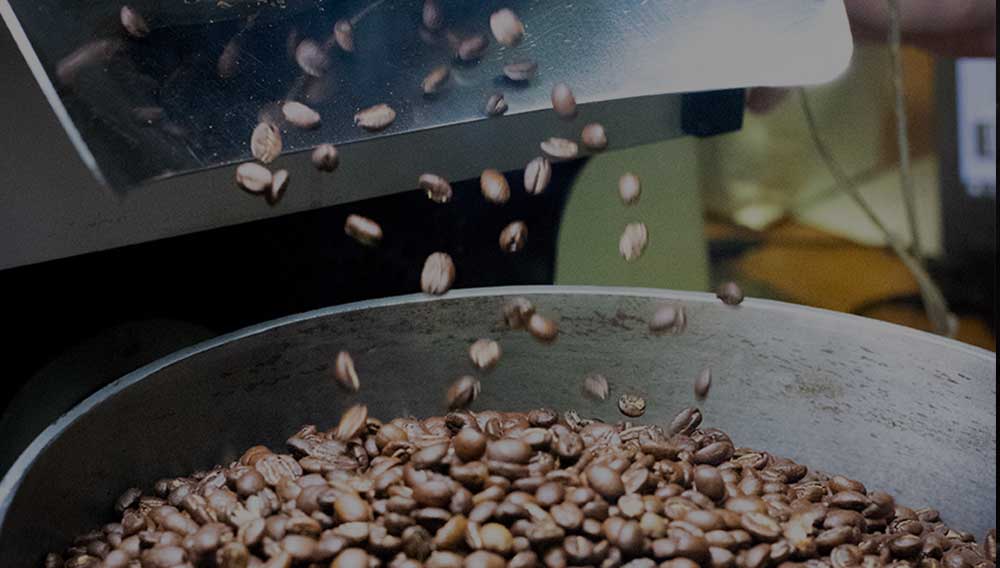
Selecting the right coffee roaster is essential for ensuring high-quality and consistent coffee for your customers. The quality of the coffee beans should be your primary consideration. Look for roasters who source premium beans and provide detailed information about their origin, processing methods, and flavor profiles. It’s beneficial to partner with roasters who prioritize sustainability and ethical sourcing, such as those with fair trade certification or direct trade relationships with farmers. This not only supports sustainable practices but also enhances your brand’s reputation.
Reliability and consistency are crucial; you need a supplier who can deliver on time and maintain the quality of their beans. Some roasters offer custom blends tailored to your specific taste preferences, which can help differentiate your business. Additionally, many roasters provide support beyond just supplying coffee, including barista training, equipment maintenance, and marketing assistance, which can be particularly valuable for new entrepreneurs.
Building strong relationships with local roasters can be mutually beneficial. Start by visiting local roasteries to meet the roasters and understand their processes. This personal connection can foster trust and collaboration. Maintain open communication about your needs and provide regular feedback to help them understand how they can better support your business. Collaborating on marketing efforts, such as co-branded events or promotions, can help both businesses reach a wider audience. Regular feedback and open dialogue help maintain a strong partnership and ensure continuous improvement.
Offering Pastries, Snacks, and Non-Coffee Beverages
Expanding your menu beyond coffee can attract a broader customer base and increase sales. Including a variety of pastries and baked goods, like croissants, muffins, and cookies, can complement your coffee offerings and provide customers with more choices for breakfast or a snack. Partnering with local bakeries can ensure freshness and support other small businesses.
Adding a selection of snacks, such as granola bars, nuts, and fresh fruit, can cater to customers looking for healthier options. Offering non-coffee beverages, like tea, hot chocolate, fresh juices, and smoothies, can appeal to non-coffee drinkers and those seeking variety. Seasonal specialties, such as iced drinks in summer and spiced beverages in winter, can also attract more customers.
Addressing diverse dietary needs can make your bike coffee cart more inclusive and attractive. Offering vegan and gluten-free options for pastries, snacks, and beverages ensures that more people can enjoy your products. This can include plant-based milk alternatives, gluten-free baked goods, and vegan snacks. Clearly labeling items that contain common allergens, such as nuts, dairy, or gluten, helps customers make informed choices and builds trust. Allowing customization of orders, such as choosing different types of milk or sugar substitutes, can further enhance customer satisfaction and loyalty.
Operational Strategies for Success
Crafting a well-thought-out menu is essential for the success of your bike coffee cart. A simple yet diverse menu will appeal to a broad customer base, while seasonal and specialty offerings can create excitement and encourage repeat business.
Crafting a Simple Yet Diverse Menu
When developing your menu, aim for simplicity to ensure efficient operations while offering enough variety to cater to different tastes. Start with a core selection of coffee beverages, such as espresso, americano, latte, cappuccino, and flat white. These classics are the backbone of any coffee menu and are well-loved by many.
Next, consider offering a few variations to appeal to different preferences. For example, include options for different milk types, such as whole milk, skim milk, almond milk, oat milk, and soy milk. This allows customers with dietary restrictions or preferences to find something suitable.
In addition to coffee, include a selection of teas, hot chocolate, and perhaps a few cold beverages like iced coffee, iced tea, or lemonade. This ensures that non-coffee drinkers and those looking for a refreshing alternative can also find something they enjoy.
Seasonal and Specialty Offerings

Cost Analysis and Pricing Strategies
Start by conducting a thorough cost analysis. Identify all the costs involved in producing and selling each item on your menu. These costs can be categorized into direct costs and indirect costs.
Direct Costs: These include the cost of raw materials (coffee beans, milk, syrups), packaging (cups, lids, napkins), and any food items (pastries, snacks). It also includes the cost of labor, especially if you have employees helping with the cart.
Indirect Costs: These encompass overhead costs such as permits, insurance, equipment maintenance, fuel for the bike, marketing expenses, and other operational costs. It’s crucial to account for these to ensure that your pricing covers all expenses.
Once you have a clear understanding of your costs, you can use a few common pricing strategies:
Markup Pricing: Add a fixed percentage to the cost of each product to determine its selling price. For example, if a latte costs you $2 to make and you apply a 150% markup, you would price it at $5.
Competition-Based Pricing: Analyze the prices of similar products offered by competitors in your area. Aim to set your prices within a competitive range. If you offer unique products or superior quality, you might justify slightly higher prices.
Value-Based Pricing: Set prices based on the perceived value to the customer rather than the actual cost. This strategy works well if your brand is well-regarded, or your products have unique features or superior quality.
Ensuring Competitive Yet Profitable Pricing
To ensure your prices are competitive yet profitable, follow these steps:
- Market Research: Regularly research your competitors’ pricing. Visit other coffee carts, cafés, and mobile food vendors to understand their pricing structures. Look at both direct competitors (other coffee vendors) and indirect competitors (cafés, fast-food chains offering coffee).
- Adjust for Perception: Sometimes, slight price adjustments can make a significant difference in customer perception. For instance, pricing an item at $4.95 instead of $5 can make it appear more affordable.
- Monitor and Adjust: Continuously monitor your sales and customer feedback. If certain items aren’t selling well, it might be due to pricing. Conversely, if items are flying off the shelf, you might be able to increase the price slightly without affecting sales volume.
- Bundle and Upsell: Create combo deals or bundles to encourage customers to spend more. For example, offering a coffee and pastry combo at a slight discount compared to buying them separately can increase the average transaction value.
- Premium Pricing for Specialty Items: For specialty drinks or seasonal offerings, consider premium pricing. Customers often expect to pay more for unique or limited-time products.
Finding the Best Locations
Choosing the right location is crucial for the success of your bike coffee cart business. High-traffic areas and strategic partnerships with local businesses can significantly boost your visibility and sales.
High-Traffic Areas and Events
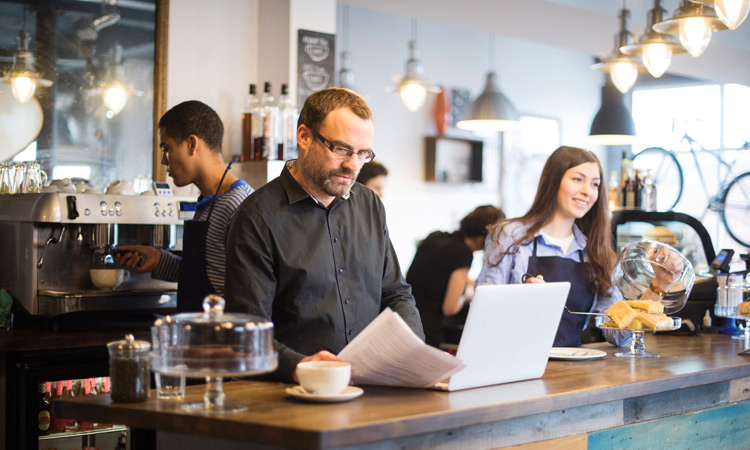
Operating in high-traffic areas ensures a steady flow of potential customers. Consider the following types of locations:
- Business Districts: These areas are bustling with office workers looking for their morning coffee or a mid-day pick-me-up. Positioning your cart near large office buildings or business parks can attract a regular customer base.
- Tourist Attractions: Popular tourist spots, such as historical landmarks, museums, or parks, can provide a continuous stream of new customers. Tourists often seek out convenient and quick refreshment options.
- Universities and Colleges: Campuses are filled with students and staff who need caffeine to get through their busy days. Setting up near student centers, libraries, or dormitories can tap into this large customer base.
- Public Transportation Hubs: Locations near bus stops, train stations, or subway entrances are ideal for capturing commuters. These spots are typically busy throughout the day with people looking for quick coffee options.
- Events and Festivals: Participating in local events, such as farmers’ markets, music festivals, sports events, and community fairs, can introduce your business to a large number of potential customers in a short period. These events often attract coffee lovers who appreciate artisanal beverages.
Building Partnerships with Local Businesses
Forming partnerships with local businesses can create mutually beneficial relationships and increase your customer base. Here are some strategies:
- Collaborate with Local Retailers: Partner with nearby shops and boutiques to offer exclusive deals or discounts for their customers. For example, you could provide a discount to customers who show a receipt from a partner store.
- Work with Offices and Coworking Spaces: Arrange to provide coffee services to offices or coworking spaces. This could be in the form of a regular morning setup or catering for special events and meetings.
- Engage with Fitness Centers and Gyms: Health-conscious gym-goers often seek out high-quality coffee and snacks. Setting up near gyms or forming a partnership to provide post-workout refreshments can be highly effective.
- Connect with Educational Institutions: Schools, colleges, and training centers can be excellent partners. Offering special promotions for students and staff or catering school events can increase your visibility and customer loyalty.
- Local Events Sponsorships: Sponsor local events or community gatherings to get your brand noticed. Providing coffee at charity runs, local sports games, or neighborhood meetings can build goodwill and introduce your business to new customers.
Marketing and Promoting Your Bike Coffee Cart
Establishing a robust online presence is essential for the success of your bike coffee cart business. This includes utilizing social media and a website effectively and engaging with customers through email and newsletters.
Utilizing Social Media and a Website
Social Media: Social media platforms like Instagram, Facebook, and Twitter are powerful tools for promoting your business and engaging with customers. Instagram, with its focus on visual content, is ideal for showcasing your coffee creations, behind-the-scenes operations, and the various locations you visit. Use high-quality images and videos to capture attention. Regularly posting updates, stories, and engaging content like polls and Q&A sessions can help build a loyal following.
Facebook can be used to create a business page where you can share detailed updates, and event information, and engage in longer discussions with your followers. Utilize Facebook Events to promote your participation in local markets or festivals. Twitter is great for quick updates, engaging in trending conversations, and connecting with the local community.
Website: A professional website acts as your business’s online home. It should provide essential information about your bike coffee cart, including your menu, operating hours, locations, and contact information. Consider including a blog where you can share stories about your journey, coffee tips, and upcoming events. An online store can be an additional revenue stream, selling branded merchandise or pre-packaged coffee beans.
Ensure your website is mobile-friendly, as many customers will access it from their phones. Optimize it for search engines (SEO) so that potential customers can easily find you online.
Engaging with Customers Through Email and Newsletters
Email Marketing: Collecting email addresses from your customers allows you to engage with them directly. Offer a sign-up form on your website and social media, perhaps incentivized with a discount or a free item on their next visit.
Newsletters: Regular newsletters can keep your customers informed and engaged. Include updates about new menu items, special promotions, upcoming events, and stories about your business. Personalized content, such as birthday discounts or special offers based on past purchases, can enhance customer loyalty.
Customer Engagement: Use emails to gather feedback and encourage reviews. Sending out surveys or simply asking for feedback on recent purchases can provide valuable insights and make customers feel valued. Highlight positive reviews and customer testimonials in your newsletters and on social media to build trust and attract new customers.
By effectively utilizing social media and maintaining an informative website, coupled with engaging email marketing, you can build a strong online presence that attracts and retains customers, driving the success of your bike coffee cart business.
Effectively marketing your bike coffee cart within the local community can significantly boost your visibility and customer base. Here are two powerful strategies: participating in community events and markets, and offering promotions and loyalty programs.
Participating in Community Events and Markets
Engaging with the community by participating in local events and markets is a great way to increase your presence and attract new customers. Local events such as farmers’ markets, street fairs, music festivals, and sports events draw large crowds and offer a prime opportunity to introduce your coffee cart to a broad audience.
To maximize your impact at these events, ensure your setup is attractive and inviting. Use clear signage, and eye-catching displays, and offer samples to entice people to try your coffee. Engage with attendees by sharing the story of your business and what makes your coffee unique. Being personable and approachable can leave a lasting impression and encourage repeat business.
Collaborating with event organizers for co-promotions can also be beneficial. For example, if you’re part of a music festival, offering a discount to ticket holders or participating in a festival-wide loyalty program can increase your exposure. Additionally, being active in local charity events or school fundraisers can build goodwill and a positive reputation within the community.
Offering Promotions and Loyalty Programs
Promotions and loyalty programs are effective tools for attracting and retaining customers. Here are some ideas to implement:
- Promotional Discounts: Offer special discounts during slow periods, holidays, or to celebrate business milestones. For example, you might have a “Buy One Get One Free” day or offer a discount on specific menu items.
- Limited-Time Offers: Introduce limited-time specialty drinks or seasonal items that create urgency and excitement. Announce these offers through your social media channels and email newsletters to drive traffic.
- Loyalty Programs: Develop a loyalty program that rewards repeat customers. This could be a simple punch card system where customers earn a free drink after a certain number of purchases, or a more sophisticated digital rewards program where points are accumulated and redeemed via a mobile app.
- Referral Discounts: Encourage your current customers to refer friends by offering discounts or free items for successful referrals. This not only helps in acquiring new customers but also rewards your existing loyal customers.
- Collaborative Promotions: Partner with local businesses for cross-promotional deals. For example, customers who show a receipt from a nearby bookstore could get a discount on their coffee, and vice versa. This can help both businesses expand their customer base.
Word-of-mouth and referrals are powerful marketing tools that can significantly boost the success of your bike coffee cart. Encouraging customer reviews and creating memorable experiences are essential strategies for leveraging these tools effectively.
Encouraging Customer Reviews and Testimonials
Positive reviews and testimonials can enhance your reputation and attract new customers. Here’s how to encourage them:
- Ask for Reviews: After serving a customer, politely ask them to leave a review on platforms like Google, Yelp, or your social media pages. Provide clear instructions on how to leave a review and make it as easy as possible.
- Incentivize Reviews: Offer a small incentive for customers who leave a review, such as a discount on their next purchase or entry into a monthly prize draw. This encourages more customers to share their positive experiences.
- Showcase Testimonials: Highlight positive reviews and testimonials on your website, social media, and inyour cart. Displaying these endorsements can build trust and credibility with potential new customers.
- Engage with Reviews: Respond to reviews, both positive and negative. Thank customers for their feedback and address any concerns raised in negative reviews. This demonstrates that you value customer input and are committed to improving your service.
Creating Memorable Experiences for Customers
Providing exceptional service and unique experiences can turn customers into loyal advocates who spread the word about your business. Here are some ways to create memorable experiences:
- Personalized Service: Take the time to get to know your regular customers and remember their usual orders. A personalized touch makes customers feel valued and appreciated.
- High-Quality Products: Ensure that the quality of your coffee and other products consistently meets or exceeds customer expectations. Exceptional products are often a key reason customers will recommend your business to others.
- Unique Offerings: Introduce unique menu items or special promotions that give customers something to talk about. Seasonal specialties, signature drinks, or limited-time offers can create buzz and encourage word-of-mouth referrals.
- Engaging Atmosphere: Make your cart an inviting and enjoyable place to visit. Play upbeat music, have a friendly and enthusiastic staff, and maintain a clean and appealing setup.
- Customer Appreciation: Show appreciation to your customers through loyalty programs, thank-you notes, or surprise freebies. Small gestures of gratitude can leave a lasting positive impression.
Marketing and Promoting Your Bike Coffee Cart
Establishing a robust online presence is essential for the success of your bike coffee cart business. This includes utilizing social media and a website effectively and engaging with customers through email and newsletters.

Utilizing Social Media and a Website
Social Media: Social media platforms like Instagram, Facebook, and Twitter are powerful tools for promoting your business and engaging with customers. Instagram, with its focus on visual content, is ideal for showcasing your coffee creations, behind-the-scenes operations, and the various locations you visit. Use high-quality images and videos to capture attention. Regularly posting updates, stories, and engaging content like polls and Q&A sessions can help build a loyal following.
Facebook can be used to create a business page where you can share detailed updates, and event information, and engage in longer discussions with your followers. Utilize Facebook Events to promote your participation in local markets or festivals. Twitter is great for quick updates, engaging in trending conversations, and connecting with the local community.
Website: A professional website acts as your business’s online home. It should provide essential information about your bike coffee cart, including your menu, operating hours, locations, and contact information. Consider including a blog where you can share stories about your journey, coffee tips, and upcoming events. An online store can be an additional revenue stream, selling branded merchandise or pre-packaged coffee beans.
Ensure your website is mobile-friendly, as many customers will access it from their phones. Optimize it for search engines (SEO) so that potential customers can easily find you online.
Engaging with Customers Through Email and Newsletters
Email Marketing: Collecting email addresses from your customers allows you to engage with them directly. Offer a sign-up form on your website and social media, perhaps incentivized with a discount or a free item on their next visit.
Newsletters: Regular newsletters can keep your customers informed and engaged. Include updates about new menu items, special promotions, upcoming events, and stories about your business. Personalized content, such as birthday discounts or special offers based on past purchases, can enhance customer loyalty.
Customer Engagement: Use emails to gather feedback and encourage reviews. Sending out surveys or simply asking for feedback on recent purchases can provide valuable insights and make customers feel valued. Highlight positive reviews and customer testimonials in your newsletters and on social media to build trust and attract new customers.
By effectively utilizing social media and maintaining an informative website, coupled with engaging email marketing, you can build a strong online presence that attracts and retains customers, driving the success of your bike coffee cart business.
Effectively marketing your bike coffee cart within the local community can significantly boost your visibility and customer base. Here are two powerful strategies: participating in community events and markets, and offering promotions and loyalty programs.
Participating in Community Events and Markets
Engaging with the community by participating in local events and markets is a great way to increase your presence and attract new customers. Local events such as farmers’ markets, street fairs, music festivals, and sports events draw large crowds and offer a prime opportunity to introduce your coffee cart to a broad audience.
To maximize your impact at these events, ensure your setup is attractive and inviting. Use clear signage, and eye-catching displays, and offer samples to entice people to try your coffee. Engage with attendees by sharing the story of your business and what makes your coffee unique. Being personable and approachable can leave a lasting impression and encourage repeat business.
Collaborating with event organizers for co-promotions can also be beneficial. For example, if you’re part of a music festival, offering a discount to ticket holders or participating in a festival-wide loyalty program can increase your exposure. Additionally, being active in local charity events or school fundraisers can build goodwill and a positive reputation within the community.
Offering Promotions and Loyalty Programs
Promotions and loyalty programs are effective tools for attracting and retaining customers. Here are some ideas to implement:
- Promotional Discounts: Offer special discounts during slow periods, holidays, or to celebrate business milestones. For example, you might have a “Buy One Get One Free” day or offer a discount on specific menu items.
- Limited-Time Offers: Introduce limited-time specialty drinks or seasonal items that create urgency and excitement. Announce these offers through your social media channels and email newsletters to drive traffic.
- Loyalty Programs: Develop a loyalty program that rewards repeat customers. This could be a simple punch card system where customers earn a free drink after a certain number of purchases, or a more sophisticated digital rewards program where points are accumulated and redeemed via a mobile app.
- Referral Discounts: Encourage your current customers to refer friends by offering discounts or free items for successful referrals. This not only helps in acquiring new customers but also rewards your existing loyal customers.
- Collaborative Promotions: Partner with local businesses for cross-promotional deals. For example, customers who show a receipt from a nearby bookstore could get a discount on their coffee, and vice versa. This can help both businesses expand their customer base.
Word-of-mouth and referrals are powerful marketing tools that can significantly boost the success of your bike coffee cart. Encouraging customer reviews and creating memorable experiences are essential strategies for leveraging these tools effectively.
Encouraging Customer Reviews and Testimonials
Positive reviews and testimonials can enhance your reputation and attract new customers. Here’s how to encourage them:
- Ask for Reviews: After serving a customer, politely ask them to leave a review on platforms like Google, Yelp, or your social media pages. Provide clear instructions on how to leave a review and make it as easy as possible.
- Incentivize Reviews: Offer a small incentive for customers who leave a review, such as a discount on their next purchase or entry into a monthly prize draw. This encourages more customers to share their positive experiences.
- Showcase Testimonials: Highlight positive reviews and testimonials on your website, social media, and inyour cart. Displaying these endorsements can build trust and credibility with potential new customers.
- Engage with Reviews: Respond to reviews, both positive and negative. Thank customers for their feedback and address any concerns raised in negative reviews. This demonstrates that you value customer input and are committed to improving your service.
Creating Memorable Experiences for Customers
Providing exceptional service and unique experiences can turn customers into loyal advocates who spread the word about your business. Here are some ways to create memorable experiences:
- Personalized Service: Take the time to get to know your regular customers and remember their usual orders. A personalized touch makes customers feel valued and appreciated.
- High-Quality Products: Ensure that the quality of your coffee and other products consistently meets or exceeds customer expectations. Exceptional products are often a key reason customers will recommend your business to others.
- Unique Offerings: Introduce unique menu items or special promotions that give customers something to talk about. Seasonal specialties, signature drinks, or limited-time offers can create buzz and encourage word-of-mouth referrals.
- Engaging Atmosphere: Make your cart an inviting and enjoyable place to visit. Play upbeat music, have a friendly and enthusiastic staff, and maintain a clean and appealing setup.
- Customer Appreciation: Show appreciation to your customers through loyalty programs, thank-you notes, or surprise freebies. Small gestures of gratitude can leave a lasting positive impression.
Managing and Growing Your Business
Day-to-Day Operations
Running a successful bike coffee cart requires effective management of daily operations, including inventory management and customer service. Here’s how to handle these essential aspects:
Inventory Management and Replenishment
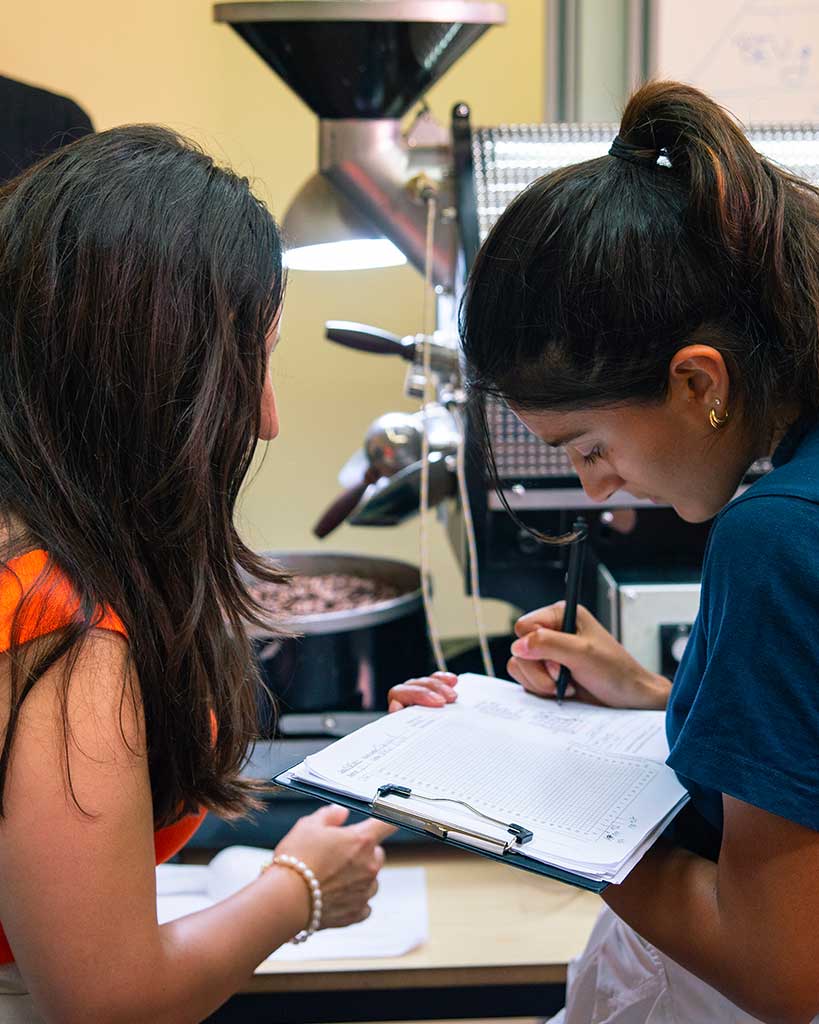
Efficient inventory management is crucial to ensure you always have the necessary supplies without overstocking, which can lead to waste and increased costs. Here are some strategies:
- Track Inventory Regularly: Keep a detailed record of your inventory, noting what items are used daily and what needs to be replenished. Use inventory management software or a simple spreadsheet to track stock levels and usage patterns.
- Set Par Levels: Establish minimum stock levels for each item. When inventory falls below these levels, it’s time to reorder. This helps prevent running out of essential supplies during busy times.
- Regular Replenishment Schedule: Develop a regular replenishment schedule based on your sales patterns. For example, if you notice that you go through a certain amount of coffee beans each week, schedule deliveries accordingly.
- Monitor Shelf Life: Pay attention to the shelf life of perishable items like milk, pastries, and certain syrups. Implement a first-in, first-out (FIFO) system to ensure older stock is used before newer stock, reducing waste due to expiration.
- Supplier Relationships: Maintain good relationships with your suppliers to ensure timely deliveries and possibly negotiate better terms or bulk discounts. Reliable suppliers are key to keeping your inventory stocked without interruptions.
Customer Service Best Practices
Exceptional customer service can set your bike coffee cart apart and build a loyal customer base. Here are some best practices:
- Friendly and Professional Interaction: Always greet customers with a smile and be courteous. Personalize interactions by remembering regular customers’ names and preferences.
- Efficient Service: Speed is crucial in a mobile coffee business. Ensure your setup allows for quick and efficient service, minimizing wait times. Well-trained staff and a streamlined workflow can significantly improve service speed.
- Quality and Consistency: Consistently deliver high-quality products. Ensure all beverages are prepared to the same high standard every time, which can be achieved through regular staff training and quality control checks.
- Handle Complaints Gracefully: If a customer has a complaint, address it promptly and professionally. Apologize for any inconvenience, offer a solution (like a replacement or refund), and use the feedback to improve your service.
- Engage with Customers: Create a welcoming atmosphere by engaging with your customers. Ask for feedback, share stories about your business, and build a community around your cart. Use social media to stay connected with your customers outside of their visits.
- Cleanliness and Hygiene: Maintain a clean and hygienic environment. Regularly clean your equipment and surfaces, and ensure all food safety standards are met. A clean cart reassures customers about the quality and safety of your products.
Budgeting and Accounting Tips
Effective financial management is essential for the sustainability and growth of your bike coffee cart business. This involves proper budgeting, accurate accounting, and diligent tracking of expenses and revenue.
Create a Detailed Budget: Start by developing a comprehensive budget that outlines all expected income and expenses. Include fixed costs such as permits, insurance, and equipment maintenance, as well as variable costs like inventory and labor. Break down your budget into monthly projections to monitor financial performance over time.
Separate Business and Personal Finances: Keep your business and personal finances separate. Open a dedicated business bank account and use accounting software to manage your finances. This separation simplifies tracking expenses and revenue and ensures accurate financial reporting.
Use Accounting Software: Invest in reliable accounting software like QuickBooks, Xero, or FreshBooks. These tools help automate financial tasks, track expenses, manage invoices, and generate financial reports. They also assist in tax preparation by organizing all financial records in one place.
Monitor Cash Flow: Regularly review your cash flow to ensure you have enough liquidity to cover operating expenses. Positive cash flow is crucial for meeting day-to-day financial obligations and investing in business growth. Track inflows and outflows of cash to avoid shortfalls.
Plan for Taxes: Understand your tax obligations and set aside funds to cover them. Depending on your location, you may need to pay sales tax, income tax, and other business-related taxes. Consulting with a tax professional can help ensure compliance and optimize your tax strategy.
Track Key Financial Metrics: Monitor key performance indicators (KPIs) such as gross profit margin, net profit margin, and return on investment (ROI). These metrics provide insights into your business’s financial health and help identify areas for improvement.
Tracking Expenses and Revenue
Maintain Accurate Records: Keep detailed records of all transactions, including sales, purchases, and expenses. This documentation is essential for accurate financial reporting and can help identify trends or anomalies in your financial data.
Categorize Expenses: Categorize your expenses into different categories such as inventory, utilities, marketing, and labor. This categorization helps in understanding where your money is going and can highlight areas where you might cut costs or need to invest more.
Regularly Reconcile Accounts: Reconcile your bank statements with your accounting records regularly to ensure accuracy. This process helps identify any discrepancies and ensures that all transactions are accounted for.
Analyze Revenue Streams: Break down your revenue by product or service to understand which items are the most profitable. This analysis can guide your pricing strategy, inventory management, and marketing efforts.
Monitor Sales Trends: Track daily, weekly, and monthly sales to identify patterns and seasonal fluctuations. Understanding these trends can help you anticipate busy periods and adjust your inventory and staffing accordingly.
Set Financial Goals: Establish short-term and long-term financial goals for your business. These goals should be specific, measurable, achievable, relevant, and time-bound (SMART). Regularly review your progress toward these goals and adjust your strategies as needed.
Expanding to Multiple Carts or Locations
Scaling up your bike coffee cart business can involve expanding to multiple carts or locations and diversifying your product offerings. Both strategies can significantly increase your market reach and revenue potential.
Assess Demand and Feasibility: Before expanding, conduct market research to ensure there is sufficient demand in new areas. Analyze foot traffic, local competition, and customer demographics. Consider the logistical and operational challenges of managing multiple locations.
Standardize Operations: Develop standardized procedures and protocols to ensure consistency across all carts. This includes standardizing recipes, service procedures, and inventory management systems. Creating detailed operation manuals can help maintain quality and efficiency.
Hire and Train Staff: Expanding to multiple carts will require additional staff. Hire reliable employees and provide comprehensive training to ensure they can operate the carts independently while maintaining high standards of service. Implement a system for regular performance reviews and continuous training.
Leverage Technology: Utilize technology to streamline operations and manage multiple locations effectively. Use cloud-based inventory management and sales tracking systems to monitor performance across all carts in real time. Communication tools like team messaging apps can help keep everyone coordinated.
Explore Franchising: If your business model is successful, consider franchising as a way to expand rapidly with lower capital investment. Franchising allows you to leverage other entrepreneurs’ resources and local market knowledge while maintaining control over your brand and business standards.
Diversifying Product Offerings
Introduce New Beverages: Expand your menu to include a variety of new drinks. This could involve seasonal specialties, cold brews, specialty teas, and innovative coffee blends. Offering a diverse range of beverages can attract a broader customer base.
Add Food Items: Introduce a selection of food items that complement your coffee offerings. This could include sandwiches, wraps, salads, and breakfast items like yogurt parfaits and oatmeal. Partnering with local bakeries or food suppliers can help provide fresh and high-quality food options.
Cater to Dietary Preferences: Include options that cater to various dietary needs and preferences, such as vegan, gluten-free, and low-sugar items. Offering a variety of choices can appeal to health-conscious consumers and those with dietary restrictions.
Offer Merchandise: Selling branded merchandise, such as mugs, reusable cups, t-shirts, and tote bags, can create an additional revenue stream and increase brand visibility. High-quality and stylish merchandise can also serve as marketing tools as customers use them in their daily lives.
Implement Subscription Services: Consider offering subscription services for regular customers. This could include monthly coffee bean deliveries, pre-paid drink packages, or a loyalty program with exclusive perks. Subscription models can provide a steady revenue stream and enhance customer loyalty.
Conclusion
In this comprehensive guide, we have covered the essential steps and considerations for starting a bike coffee cart business. From understanding the concept and its advantages, planning your business, and designing and equipping your cart, to marketing and operational strategies, we have provided a roadmap to help you succeed in this unique and exciting venture.
We began by exploring the concept of a bike coffee cart, highlighting its benefits such as low start-up costs, mobility, and eco-friendliness. We then delved into the importance of thorough planning, including market research, choosing a business model, and navigating legal and regulatory considerations.
Designing and equipping your cart with the right tools, selecting quality coffee and complementary products, and creating a strong brand identity were also discussed. We emphasized the significance of efficient day-to-day operations, including inventory management, customer service, and financial management, as well as strategies for scaling up your business through expansion and diversification.
Aspiring bike coffee cart entrepreneurs are encouraged to take the leap and embark on this rewarding journey. With passion, dedication, and the insights provided in this guide, you are well-equipped to turn your vision into reality. Remember, every successful business starts with a well-thought-out plan and a commitment to excellence.
For those seeking further learning and support, we invite you to join the Espresso Academy courses and consultations. Our programs are designed to provide in-depth knowledge and practical skills to help you excel in the coffee industry. Whether you’re looking to refine your barista skills, learn more about business management, or explore advanced coffee techniques, Espresso Academy is here to support your entrepreneurial journey.
Sign up for our courses, contact us for personalized consulting services, and follow us on social media for updates, tips, and inspiration. Together, let’s brew success and create a thriving bike coffee cart business.



